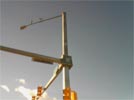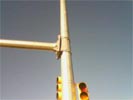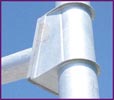

MPC |
 |
 |
 |
| Colorado DOT Box | Colorado DOT Plate with clamps and gussets | Wyoming DOT Stiffened Box |
Figure 1. Three Typical Large Connections
Connection designs, specifically in the windy plains, coastal and mountain states, are significantly affected because of higher than average wind speeds. A new approach (or significant refinements in the present) is required to better define where fatigue design is truly required.
Phase I illustrated that the use of Wind Resource Maps (power maps) for traffic signal structures shows significant promise in predicting fatigue damage and locations where fatigue design is critical. Additionally, and just as important, where fatigue design is not critical and, therefore, more economical joints could be used.
Phase II work will focus on obtaining updated inspection data from the Phase I states considered and including more states in the database. In short, more data are necessary in order to develop the seminal work and write guidelines that could be considered by the AASHTO T12 Signs and Luminaires Committee for inclusion in the specifications.
Validate the use of wind power maps to predict fatigue damage in traffic signal poles using DOT fatigue inspection data as the basis. Suggest specification modifications based upon the findings for traffic-signal and high-mast poles.
The following tasks will be performed:
#6 Work Zone Safety
#11 Traffic Operations and Management
#18 Economic Analysis of Investments and Impacts
Overview: Connection details within traffic signal and sign structures are cracking and several failures have occurred. This issue has been the subject of several investigations and the AASHTO specification for design of these structures has been modified to address fatigue.
Vibrations in traffic signal structures are initiated by several wind-induced phenomena. Fatigue damage is cumulative and is a function of wind characteristics, including the velocity and time over which the wind is present. Wind power density spectra developed for electric power generation planning were correlated to signal pole inspection data in Phase I. The correlation shows promise, see Figure 2.

Prior to the Phase I work, no research has combined the wind power spectra developed for power generation with the fatigue problem. Correlation with wind power could lead to criteria for specification-based design referencing existing wind-power maps developed by DOE to locate generators (see http://rredc.nrel.gov/wind/pubs/atlas/). The research is novel.
Wind Power as a Predictor: Because the factors desired for wind power production are similar to those believed to cause wind-induced vibrations in traffic-signal structures, a correlation between wind power classes and incidences of fatigue cracks in traffic signal structures has have a significant impact on economy of signal and light structures. More data are necessary to accomplish this goal.
Phase I work illustrated:
Figure 2 suggests that a correlation exists between wind power density and fatigue crack incidences. The highest percentages of crack occurrences are typically found in regions with a wind class region of 3 or higher. This figure represents approximately 2500 structures - the weighted mean values are shown in the figure (dots).
Since the Phase I project began, several more states have inspected their traffic-signal and high-mast inventories. Importantly, states are located in a variety of wind power regions. Summary -- The phase I work definitely confirmed the research hypothesis; however more data are necessary for implementation.
Research Methodology: More data from several DOTs are required in order to validate this approach to the level of confidence required for specification adoption. The inspection data from state and local DOTs located in windy areas and non-windy areas will be obtained.
The additional data will be quantified in a manner similar to Phase I. These data will also provide records based upon independent inspections and procedures in case there is any bias particular to specific DOTs. Data will be studied as an aggregate and also by segregating the data by agency and region.
The authors hope to present this work at TRB and/or in a journal. They will also report to the AASHTO Subcommittee on Bridges and Structures (T-12) that helps to maintain the AASHTO Specifications associated with the design of ancillary structures.
July 1, 2009 through June 30, 2010
$99,943.00
$49,535.00
Fatigue, vortex shedding, structural engineering, wind power